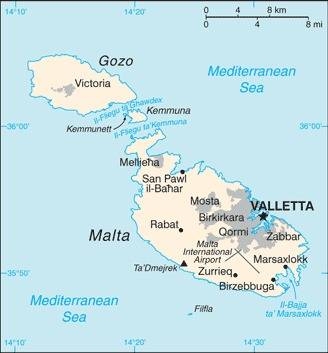91 Malta

Two equal vertical bands of white (hoist side) and red. In the upper hoist-side corner is a representation of the George Cross, edged in red. According to legend, the colors are taken from the red and white checkered banner of Count Roger of Sicily who removed a bi-colored corner and granted it to Malta in 1091. An uncontested explanation is that the colors are those of the Knights of Saint John who ruled Malta from 1530 to 1798. In 1942, King George VI of the UK awarded the George Cross to the islanders for their exceptional bravery and gallantry in World War II. Since independence in 1964, the George Cross bordered in red has appeared directly on the white field.
Flag courtesy of the CIA World Factbook

Map courtesy of the CIA World Factbook

Comino, formerly called Ephaestia, is a small (3.5 sq km; 1.4 sq mi) bird sanctuary and nature reserve island in the Mediterranean Sea. Between Comino and the adjacent islet of Cominotto lie the transparent cyan waters of the Blue Lagoon, a picturesque bay with a white sandy base and rich marine life. The long and narrow bay surrounded by rock and a bit of sand is almost like a pool, making it ideal for swimming, snorkeling, scuba diving, or relaxing on the beach.
Photo courtesy of the CIA World Factbook
Government
According to Britannica, the 1964 constitution, under which Malta became an independent monarchy and parliamentary state, was amended in 1974 to make Malta a republic within the Commonwealth. Malta is currently a unitary multiparty republic. The Maltese parliament consists of a unicameral House of Representatives and is fashioned on the British model. Members of the parliament are elected by proportional representation for five-year terms. An amendment adopted in 1996 guarantees a majority of seats to a party receiving more than 50 percent of the total votes cast in the general election. The parliament appoints the president, who is head of state. The president acts on the advice of the cabinet, which is headed by the prime minister, who is the head of the government.
Local government was established in Malta in 1993. The country is divided into 68 localities, 14 of which are in Gozo. Each locality is administered by a local council elected by the residents of the locality by proportional representation every three years. The Department for Local Government oversees the councils.
Maltese law, which was codified mainly during the period from 1854 to 1873, is largely based on the Napoleonic Code and Napoleonic law. Criminal proceedings and fiscal and maritime legislation follow English common law, but judicial precedent is not binding. Maltese is the language of the courts. Civil and criminal jurisdiction is almost exclusively vested in the Superior Courts and the Court of Magistrates. The chief justice and other members of the judiciary are appointed by the president on the advice of the prime minister.
Transport Malta
The Civil Aviation Directorate within Transport Malta regulates all aviation activities in Malta due to membership of the following organizations:
- The International Civil Aviation Organization (ICAO)
- The European Civil Aviation Conference (ECAC)
- EUROCONTROL
- The European Aviation Safety Agency (EASA)
The Civil Aviation Directorate ensures that the Maltese air transport industry, in all its aspects, continues to be developed in a safe and efficient manner in order to serve the island’s needs. The Civil Aviation Directorate has a range of responsibilities and offers a selection of services to ensure the safety of those involved and to regulate all practices. The Civil Aviation Directorate is responsible for:
- The safety of aircraft
- Aircraft and aerodrome operators
- Air navigation service providers
- The licensing of aeronautical personnel
- The conclusion of international air services agreements
Airspace
SkyVector – Google Maps – ADS-B Exchange
ICAO countries publish an Aeronautical Information Publication (AIP). This document is divided into three parts: General (GEN), En Route (ENR) and Aerodromes (AD). ENR 1.4 details the types of airspace classes they chose to adopt from classes A through G.
Drone Regulations
Light UAS Operator Certificate – LUC
Advanced Air Mobility (AAM) Regulations & Policies
Bilateral agreements facilitate the reciprocal airworthiness certification of civil aeronautical products imported/exported between two signatory countries. A Bilateral Airworthiness Agreement (BAA) or Bilateral Aviation Safety Agreement (BASA) with Implementation Procedures for Airworthiness (IPA) provides for airworthiness technical cooperation between the FAA and its counterpart civil aviation authorities.
Reciprocal acceptance of aviation safety-related approvals and services with the European Union Aviation Safety Agency (EASA) and Member States of the European Union are primarily governed by the U.S. – European Union Safety Agreement.
Advanced Air Mobility (AAM) News
None found by the author.
However, should you, the reader, happen to stumble across something to the contrary, please email the author at FISHE5CA@erau.edu and you may be mentioned in the ACKNOWLEDGEMENTS section of this book by way of thanks for contributing to this free eBook!
Short Essay Questions
Scenario-Based Question
You have been hired by a Drone Startup Company. Your boss has immediately assigned this job to you.
They need you to prepare a one-page memo detailing the legalities of using a drone to film in Comino, pictured above.
They need you to mention any national laws and local ordinances.
They specifically want to know what airspace (insert pictures) you will be operating in and whether or not you need an airspace authorization.
Does it matter whether or not you are a citizen of the country?
Lastly, there is a bonus for you if, as you scroll through this chapter, you find any typos or broken links!
Short Essay Questions
- What are the drone categories?
- How is registration addressed?
- How is remote ID addressed?
- What are the model aircraft rules?
- What are the commercial drone rules?
- Are there waivers or exemptions to the rules? If so, for what?
- Would you share a link to an interactive airspace map?
- How is BVLOS addressed?
- How can you fly drones at night?
- How can you fly drones over people?
- Where do you find drone NOTAMs?
- What are the rules for drone maintenance?
- What are the rules for an SMS program?
- What are some unique rules not mentioned above?
- What are the C-UAS rules?
- What are the AAM rules?

